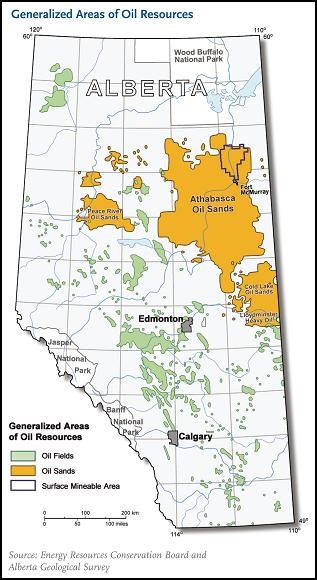According to the American Petroleum Institute, the majority of bitumen is produced through surface mining, but this is limited by the fact that only about 20% of oil sands resources are recoverable in this way. This has led several companies to pioneer new “in-situ” techniques for extracting these resources from deposits that are too deep to mine effectively. In-situ, Latin for “in position,” involves drilling a well to extract bitumen and is often accompanied by a technique called Steam-Assisted Gravity Drainage (SAGD), which involves pumping steam through a horizontal well to liquefy the bitumen, so that it can flow down into a second horizontal well and be pumped to the surface. Another process similar to SAGD is called Cyclic Steam Stimulation (CSS), which differs from SAGD in that it uses only one well pipe for both the injection of steam and the extraction of bitumen. It does this by injecting steam and allowing the well to “soak” before reversing the flow to draw out the liquefied bitumen. ExxonMobil and Imperial Oil, which claim the first patents for both SAGD and CSS, have discussed other assistive techniques in recent presentations including some involving the injection of solvents and diluents into the reservoir itself.
The World Energy Council reports that bitumen exists in 598 deposits spread across 23 countries including Venezuela, Russia, Kazakhstan, and Canada. But when one thinks of oil sands, Canada is often the first place to come to mind since the country not only hosts some of the largest oil sands resources in the world, but also has been a proving ground for many new recovery techniques. Canada’s oil sands resources are located in three major deposits: 1) the Athabasca deposits located in Northeast Alberta, 2) the Cold Lake deposits which are also in Northeast Alberta, and 3) the Peace River deposits in Northwest Alberta. These three areas collectively contain estimated recoverable reserves of 169 billion barrels according to Alberta Energy Resources Conservation Board figures and account for about 98% of total Canadian proved crude oil reserves. These massive oil sands deposits are sufficient on their own to earn the country a third place spot globally in terms of total proved crude reserves.
Being at the forefront of oil sands development, operators in Canada are encountering many challenges related to resource intensity and transportation. Both surface mining and in-situ are water intensive processes and in-situ especially requires quite a bit of energy, often in the form of natural gas to turn the water into steam. Water is usually used to remove sand and mud from the extracted bitumen and, in order to recycle as much as possible, the used water is left to sit in tailing ponds so that mud and sand sink to the bottom and the top layer can then be reused. Natural gas use is also extremely high with oil sands projects. According to the Canadian Energy Research Institute, the industry consumed approximately 1.2 Bcf/d of natural gas to produce oil sands in 2010, and that figure is expected to increase to a range of 2.75 and 3.59 Bcf/d by 2045.
Oil sands operators must be sensitive to water, natural gas, and labor costs, and not just the market price for the extracted oil because sufficient, sustained volatility in any of these key variables could result in a shift in the ultimate economic viability of the already capital intensive projects. These and other factors, such as the political environment in both Canada and the United States, are important concerns for the future of Canadian oil sands development.
With oil prices at historical highs in recent years, many operators such as ExxonMobil, Imperial Oil, Canadian Natural Resources, and ConocoPhillips have been pursuing opportunities to produce and market Canadian bitumen. This has resulted in increased demand for transportation infrastructure, such as oil pipelines to bring the product to refiners. Of key importance at the moment is the Keystone XL pipeline project which has been repeatedly delayed because of right-of-way disputes and other impediments. The pipeline addition, if completed, would run from Hardisty, Alberta to Steele City, Nebraska at a capacity of 830 MBbl/d. If all goes well - and so far it hasn't - Keystone XL could be in service by the end of 2015. But an August 2013 study by IHS CERA expresses confidence that, regardless of how things play out with Keystone, oil sands production will continue to grow at similar levels. IHS estimates oil sands production will grow from 1.9 MMBbl/d in 2013 to 4.3 MMBbl/d in 2030. This belief that the Keystone decision will not materially affect oil sands production growth is, according to IHS, based in part on the expectation of an additional 3 MMBbl/d in currently proposed pipeline capacity coming online. The study estimates 80 percent of this capacity would travel only through Canada thus avoiding U.S. government intervention. Rail is another option available to producers looking to move crude south and Canadian National Railway has made announcements about increasing Alberta crude oil shipments as recently February 2013.

According to figures from the Canadian National Energy Board, total bitumen production growth has been choppy but consistent over the past ten years, rising from a little over 118 thousand cubic meters per day in January 2003 to about 327 in August of 2013. With most production currently coming from surface mining, it will be interesting to see how growth in in-situ use affects this trend. Since the vast majority of Canadian crude exports are shipped to the United States, the future development of this resource will be of great importance to both countries.








 )
)